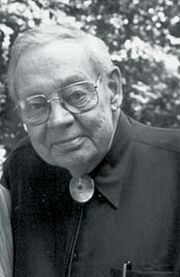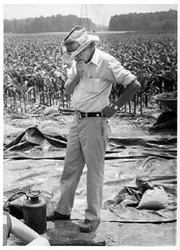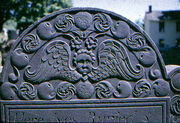
James Deetz: 1930-2000
Introduction[]
James Deetz was a well known archaeologist who emphasized the importance of 'culture' being the basis of archaeology.
The Archaeological Method[]
The archaeological method, according to Deetz, is a long and tedious process.
Archaeology and History: What is the Relationship?[]

James Deetz was specialized in one field of archaeology, and that was historical archaeology.
New England Gravestones[]

Colonial New England was an area of interest for James Deetz for conducting most of his fieldwork in historical archaeology. .
Annotated Bibliography[]
1966 Death's Heads, Cherubs and Willow Trees: Experimental Archaeology in Colonial Cemeteries. American Antiquity 31(4):502-510.
| This particular article is very informative and factual in regards to changes in styles of gravestones. Deetz's information in regards to the stylistic changes in the gravestones, is intriguing in that he connects the gravestones to the community. What I mean by community, is that these styles of gravestones do not represent any major historical event in history, but represent the cultural lifestyles of the average community member. In particular, Deetz played close attention to how religion and kinship are represented amongst the style changes of the gravestones. If an individual is researching mortuary practices and burial rituals, this article will be of interest. |
1967 Invitation to Archaeology. Natural History Press [Doubleday] for The American Museum of Natural History, Garden City, NJ.
| An informative and straight to the point book. Within this book Deetz wrote, it is organized on the basis of the archaeological method and it's steps. Deetz goes into complex detail on each of the steps, and how studying material culture needs these steps to become "facts" and or representation of a particular culture. When it comes to cultural studies in particular, Deetz indicated within this book that culture is central in the study of archaeology. Because what does archaeology do? Archaeology is the study of material culture, or "garbage" that humans have left behind. Within this book, the material culture that is identified and objects that still need identifying, are the missing link in the study of culture and how a particular society used objects. Overall this book is one of the best of Deetz's, and it lays down exactly what he wants to prove in anthropological theory. |
1988 History and Archaeological Theory: Walter Taylor Revisited. American Antiquity 53(1):13-22.
| Deetz's interpretation of how history and archaeological theory are intertwined with one another. What Deetz is interpreting within this particular article, is how the premise of archaeology cannot exist without the presence of history. Historical documents are vital in deciphering parts of the material culture of a given society. Overall, Deetz argues that history and archaeology are both part of the human experience. What is also interesting, is Deetz's interpretation of ethnography, archaeology, and history. What Deetz says, is all are interconnected, and each use different types of data: ethnographers study behavior, historians study documents, and archaeologists study the material culture. This article brings forth some very interesting points when it comes to connection all aspects of anthropology with that of history. |
1988 American Historical Archaeology: Methods and Results. Science 239:362-367.
| Deetz's interpretation of how history and archaeological theory are intertwined with one another. What Deetz is interpreting within this particular article, is how the premise of archaeology cannot exist without the presence of history. Historical documents are vital in deciphering parts of the material culture of a given society. Overall, Deetz argues that history and archaeology are both part of the human experience. What is also interesting, is Deetz's interpretation of ethnography, archaeology, and history. What Deetz says, is all are interconnected, and each use different types of data: ethnographers study behavior, historians study documents, and archaeologists study the material culture. This article brings forth some very interesting points when it comes to connection all aspects of anthropology with that of history. |
1989 Archaeography, Archaeology, or Archeology? American Journal of Archaeology 93(3):429-435.
| Some interesting 'keynote' address that Deetz put forth, was on the differences between archaeography, archaeology, and archeology. What he is demonstrating, is how these three put together maybe tearing apart the discipline of archaeology, but in reality, they make up the practice in anthropology. The combination of ethnography research and archaeology, according to Deetz, makes archaeography. The two different spellings of archaeology and archeology, is the change of thought on how archaeology should be carried out. This is a very interesting article, especially if one is interested in the differences between the spelling of archaeology or archeology, and if these two are really different. |
2000 Deetz & Deetz. The Times of Their Lives: Life, Love, and Death in the Plymouth Colony.
| An amazing and excellent piece of literature put for by Deetz. Arguably, this book demonstrates probably the best work of historical archaeology. Deetz demonstrates throughout this book the cultural lifestyles of the Plymouth colony people, and his archaeological background is evident throughout this particular piece of literature. This book definately demonstrates the best quality of Deetz's work. |
Secondary References[]
1960 An Archaeological Approach to Kinship Change in Eighteenth Century Arikara Culture. Ph.D. dissertation. Department of Anthropology, Harvard University, Cambridge, MA.
1962 Abstract of an Archaeological Approach to Eighteenth Century Arikara Kinship Change. Abstracts in New World Archaeology 2, Society for American Archaeology.
1963 Soil pH as a Tool in Archaeological Site Interpretation. American Antiquity 29(2):242-243.
1967 Eighteenth Century Cemeteries: A Demographic View. Historical Archaeology 1:40-42.
1968 The Inference of Residence and Descent from Archaeological Data. In New Perspectives in Archaeology, Lewis R. Binford and Sally Binford, editors, pp. 41-48. Aldine Press, Chicago.
1974 A Cognitive Historical Model for American Material Culture, 1620-1835. In Reconstructing Complex Societies -- An Archaeological Colloquium, Charlotte B. Moore, editor, pp. 21-29. Supplement to the Bulletin of the American Schools of Oriental Research, 20.
1976 What is archaeology? In The Evolution of Human Adaptations: Readings in Anthropology, John J. Poggie, Jr., Gretel H. Pelto, and Pertti J. Pelto, compilers, pp. 26-39. Macmillan, New York.
1977 In Small Things Forgotten: The Archaeology of Early American Life. Doubleday, Anchor Press, New York.
1993 Flowerdew Hundred: The Archaeology of a Virginia Plantation, 1619-1864. University Press of Virginia, Charlottesville.
2000-2008 Plymouth Archive project. electronic document. http://www.histarch.uiuc.edu/plymouth/tributes.html
*For more sources and publications of James Deetz's work, visit the website "Plymouth Archive Project", and go under "Tributes to James Deetz"*